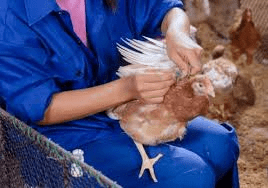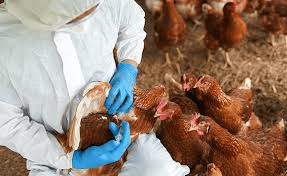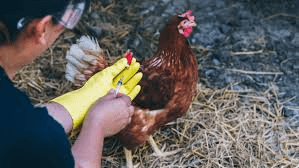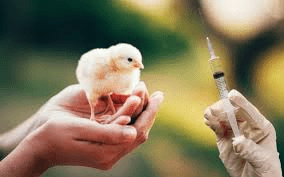Vaccination plays an important part in the health management of the poultry flock. Numerous diseases are prevented by vaccinating the chickens against them.
A vaccine helps to prevent a particular disease by triggering or boosting the bird’s immune system to produce antibodies that in turn fight the invading causal organisms.
Below is a guide on the lists of the vaccines and their route of administration for your birds:
VaccineTimeRouteND I/OBetween Day 1& 5Intraocular or nasalMarek’sDay 1Subcut (Usually done from the hatchery)1st GumboroBetween Day 7 & 10In water2nd GumboroDay 18In water3rd GumboroDay 28In waterLasotaDay 21In water1st KumarovWeek 6IntramuscularFowl poxWeek 8Wing web jabbingFowl choleraWeek 10 Fowl typhoidWeek 12 EDS VaccineBefore birds start layingSubcut2nd KumarovWeek 16IntramuscularKumarov boosterEvery 3 monthsIntramuscular
Note: This program is not rigid and is subject to the counsel of your consultant. Also, due to stress on laying birds, most farmers don’t give Komarov booster instead they give Lasota to the birds every 6weeks, let your consultant guide you more on this.
A natural invasion that causes the disease will have the same result as the bird will produce antibodies that fight the current invasion as well as prevent future invasions by the same causal organisms.
Unfortunately, birds that become diseased usually become unthrifty, non-productive, or even die. An infection caused by natural invasion is uncontrollable and thus has the potential to cause severe damage; however, vaccination provides a method of controlling the result while causing minimal harm to the birds.
Vaccines are generally fragile products, some of which are life but in a state of suspended animation. Others are dead. All have a finite life that is governed by the way they are handled and used.
Handling and administration procedures also influence the potency of many vaccines and consequently the level of immunity the bird develops.
Read Also: Poultry Vaccination/Medication Program, Dosage and Position/Method of Administration
Types of Poultry Vaccines

Live vaccine – the active part of the vaccine is the live organism that causes the disease. As such, it is capable of inducing the disease in birds that have not had previous contact with that organism.
Vaccinated birds, in many cases, can infect non-vaccinated birds if housed together.
Attenuated vaccine – The organism in this type of vaccine has been weakened by special manufacturing procedures, so it no longer can cause the severe form of the disease.
In the worst-case scenario, the birds may contract a very mild form of the disease; however, the vaccine can still stimulate the immune system to produce antibodies.
Killed vaccine – With this type of vaccine the organism has been killed and is unable to cause the disease, although the ability to trigger the immune system remains.
In many cases, the level of immunity produced by this form of the vaccine is weaker than that produced by live and attenuated vaccines.
Vaccine Production
Vaccines are produced mainly in three forms:
- Liquid vaccine – it is in a fluid form ready to use.
- Freeze-dried vaccine – the vaccine is stored as one pack of freeze-dried material and one pack of diluent, often a sterile saline solution. These have to be combined before use.
- Dust – where the vaccine is prepared for administration in the dry form.
Vaccines are sold in dose lots, the number of doses being the number of fowls that may be vaccinated with that amount of vaccine when using the recommended technique.
In the case of many vaccines, there are differences in the disease organism strains that they are effective against. The correct vaccine strain must be used and this can only be determined by veterinary advice.
Handling vaccines on the farm

Vaccines are fragile in many ways and must be handled with extreme care to maintain their potency.
In most cases, poor handling procedures will result in a rapid loss of potency.
The most important handling requirements include checking and recording the following information upon receipt of the vaccine on the farm:
- That the vaccine has been transported in the recommended manner which is usually in the chilled or frozen state. Prolonged exposure to atmospheric temperature will result in rapid loss of potency.
- Type of vaccine – is it the vaccine ordered.
- The number of doses – has the correct amount been delivered.
- The expiry date of the vaccine – vaccines have a date by which there is a significant risk that they will no longer retain their potency and will not produce the immunity required. The expiry date is based on the vaccine being handled and stored properly.
- Place the vaccine in the recommended storage conditions as soon as possible.
To find out what these are, read the instructions. However, freeze-dried material should be stored at temperatures below freezing, and diluent at temperatures just above freezing. Generally, liquid vaccines are stored at temperatures just above freezing. - Remove the vaccines from storage immediately before their being used. Only remove and re-constitute enough for immediate needs and repeat this through the day if more is required. Do NOT mix what is required for an entire day at the start of the day and leave it to stand until required, as the vaccine will rapidly lose its efficacy.
- Protect the vaccines after mixing by holding them in an ice bath. Place ice in a small esky or similar container, then place the mixed vaccine container on top of the ice. Once mixed, some vaccines naturally have a very short shelf life. For example, Marek’s Disease has a life of about 1.5 hours after mixing IF HELD IN AN ICE BATH. It is much shorter if held in higher temperatures.
- Use the recommended administration techniques and do not vary these without veterinary advice.
- Always clean and sterilize the vaccinating equipment thoroughly after use.
- Always destroy unused mixed vaccines after the task has been completed. Some vaccines have the potential to cause harm if not destroyed properly.
- Do not vaccinate birds that are showing signs of disease or stress.
Read Also: Bird flu in the Poultry Farm and How to tackle it
Vaccination procedures

There are many ways that vaccines may be administered to poultry and the correct method must be used for each vaccine. Using the wrong method will often fail the vaccine to produce the desired immunity.
Some of the methods require the operator to handle every bird and, consequently are time-consuming and stressful to the birds and operator. Other methods involve administration by methods much less stressful and time-consuming.
These methods include administration via the drinking water or as an aerosol spray. The various vaccine administration methods for poultry are listed below.
(1) In-ovo vaccination
The vaccine is administered to the embryo before hatching using the In-ovo vaccination method.
Vaccines can be administered to five different areas of the egg which include: the air cell, the allantoic sac, the amniotic fluid, the embryo’s body, and the yolk sac.
Meanwhile, the area of injection has a great impact on the vaccine uptake and, as a result, the chicken’s immune response as well. While injection in the air cell is minor/not effective, injection in the body of the embryo or the allantois sac is effective.
Therefore, the optimum period to inject the embryo is in the late stage of development, i.e. the time between the ascendance of the stalk of the yolk sac into the abdomen (about the time when the chicken tucks its head under its wings) and external pipping.
During that late stage of development, the embryo is mature enough to cope with the viral stimulus and the trauma induced by the penetrating needle is unlikely to cause severe tissue damage.
Signs of too early vaccination include reduced hatchability, late death, and an increased number of culled birds. However, if vaccination is done too late in embryonated, the risk of eggshell breakage is significantly higher.
Therefore, In-ovo vaccination is commonly performed between days 18-19 of incubation.
The system of a larger outer needle (penetrating the eggshell) that contains an inner needle (penetrating the embryo) enables for strong but careful penetration of the egg and minimizes trauma to the embryo.
Furthermore, using two needles reduces the possibility of contaminating the sterile embryo with contaminants on the outer eggshell.
The needle used to puncture the eggshell should not enter the embryonic cavity (the inner shell membrane, the chorioallantoic membrane, or air cell membrane).
While the penetration of the outer eggshell increased the relative pore volume by about 30%, the risk for increased gas exchange of the embryo occurs.
When performing in-ovo inoculation, hygiene management, such as reduced air circulation, well-maintained air filters, weather adjustment, and well-maintained hatchery insulation, must be taken into account.
Only strict management of these environmental factors can reduce the likelihood of infections of the egg, especially with aspergillosis or other air-borne pathogens.
Read Also: Guide to Proper Copper Wastes (Scrap copper) Management Process
Continuous training of reliable staff is of the highest priority to prevent reduced hatchability and to maintain high hygienic standards. A sterile environment and the usage of chlorine-based sanitizers are crucial.
The vaccine should be stored and prepared in a separate bio-secure area, and strict precautions should be taken when using sterile devices such as containers and water. While the cost of machine acquisition is high, the investment can pay back by its advantages.
The advantage of commencing immunity development before the hatch can prevent young chicks from early infection after hatch.
Since high-tech machines are used for in-ovo injection, the volume and concentration of the vaccine to be administered are highly standardized, reducing human error and labor cost when compared to vaccination of chickens later in life.
Furthermore, vaccination of every single chicken can be ensured resulting in better uniformity of the flock. Coming with this is improved animal welfare due to less handling of birds later in life.
Currently, Marek’s disease, Newcastle disease, infectious laryngotracheitis, and infectious bursal disease vaccines are routinely administered using in-ovo vaccination in various countries.
In-ovo vaccination does not interfere with maternal antibodies that may still present in the embryo. It increases the level of immunity and as a consequence one injection is sufficient to offer life-long protection against the target disease.
Read Also: How to Identify and Treat Diseases on your Fish Farm
(2) Intramuscular injection
This method involves the use of a hypodermic needle or similar equipment to introduce the vaccine into the muscle (usually the breast muscle) of the bird.
The use of an automatic syringe, which makes the technique relatively simple and does not harm the bird, greatly speeds up the process.
To ensure that the correct dose is administered to each chicken, the equipment should be checked regularly.
Care must be taken to ensure that the needle does not enter a vital organ and that no other undesirable organisms are administered to the bird at the same time by contaminated vaccine or equipment.
Good hygiene and vaccine handling procedures can help to prevent contamination.
(3) Subcutaneous injection
This method involves the use of similar equipment to that used for the intramuscular technique. The main difference between the two techniques is that, in this case, the vaccine is injected under the skin, usually at the back of the neck, and not into the muscle.
Care must be taken to ensure that the vaccine is injected into the bird and not just into the feathers or fluff in the case of very young chickens.
The dose being administered should be checked for accuracy frequently. Maintain good hygiene practices to limit the introduction of contaminating organisms during the procedure.
(4) Ocular
This method involves the vaccine being put into one of the bird’s eyes. From here the vaccine makes its way into the respiratory tract via the lacrimal duct. The vaccine is delivered through an eyedropper and care must be taken to ensure that the dropper delivers the recommended dose.
If it is too little, the level of immunity may be inadequate, while if too much, the vaccine may not treat the total flock but will run out beforehand.
(5) Nasal
This method involves introducing the vaccine into the birds’ nostrils either as dust or as a drop. Always ensure that the applicator delivers the correct dose for the vaccine being used.
(6) Oral
With this method, the vaccine dose is given in the mouth. From here it may make its way to the respiratory system or it may continue in the digestive tract before entering the body.
Read Also: Ways to Prevent Vaccine Failure on your Poultry Farm
(7) Drinking water
With this method the vaccine is added to the drinking water and, as a consequence, is less time consuming and is significantly less stressful on the birds and operator.
Take care to ensure the vaccine is administered correctly as there is much scope for error. The recommended technique observes the following:
- All equipment used for vaccination is carefully cleaned and free of detergents and disinfectants
- Only cold, clean water of drinking quality should be used
- Open the stopper of the vaccine bottle underwater
- Before vaccination, the water in the drinking trough should be consumed.
- By ensuring that all birds drink during the vaccination phase, an adequate dose of the vaccine should be administered to all.
(8) Cloacal
The vaccine is applied to the mucus membranes of the cloaca using an abrasive applicator in this method. The applicator is firstly inserted into the vaccine and then into the bird’s cloaca and turned or twisted vigorously to cause abrasion in the organ.
The vaccine enters the body through abrasion. The technique is time-consuming and stressful to the birds and care must be taken to ensure no contamination is introduced with the vaccine particularly from bird to bird. As a rule, the technique is not used on commercial farms.
(9) Feather follicle
With this method, the vaccine is introduced into the feather follicles (the holes in the skin from where the feathers grow).
In young chickens, a group of adjacent feathers or fluff is removed, and the vaccine is brushed into the empty follicles with a short, stiff-bristled brush.
To prevent the introduction of contaminant organisms with the vaccine, good hygiene is required.
(10) Wing stab
With this method, the vaccine is introduced into the wing by a special needle(s). These needles have a groove along their length from just behind the point. When dipped into the vaccine some of the vaccines remain on the needle to fill the groove.
The needle(s) are then pushed through the web just behind the leading edge of the wing and just out from its attachment to the body of the bird.
To avoid unnecessary injury to the bird, choose a location free of muscle and bone. Ensure that the needles penetrate the skin layers at the proper location.
The vaccine is frequently brushed from the needles by fluff or feathers before being brushed into the follicles.
Read Also: Difference between Poultry Vaccines and Poultry Drugs
(11) Spray
With this method, the vaccine is sprayed onto the chickens (or into the air above the chickens) using a suitable atomizer spray. The vaccine then falls onto the chickens and enters the body of other chickens as they pick at the shiny droplets of the vaccine. A small quantity may be inhaled as well.
Vaccine Monitoring
In the case of some vaccines, an important part of the procedure is to ascertain whether the vaccine has worked, or “taken”. A good example of this is the fowlpox vaccine, which is administered by wing stab.
Within 7 to 10 days after vaccination, a “take” should appear at the vaccination site. This is in the form of a small pimple one-half to one centimetre in diameter.
If the take is larger and has a cheesy core, it indicates that contaminants have been introduced either with the vaccine or with dirty vaccinating equipment.
A check for takes would involve inspecting approximately 100 birds for every 10,000 vaccinated.
Another example of whether the birds are reacting satisfactorily to the vaccination is the systemic reaction found in chickens vaccinated against infectious bronchitis disease.
In many cases, the birds react approximately 5 to 7 days after vaccination by showing signs of ill health such as a slight cough, a higher temperature, and lethargy.
When there are no obvious signs of success, blood samples may be collected and sent to a laboratory for analysis.
The standard test looks for an adequate number of the appropriate antibodies (called the titer) in the blood.
If the vaccination was unsuccessful, it may be necessary to re-vaccinate to achieve the desired level of protection.
Failure to find evidence of success could be because of:
- Faulty technique resulting in the vaccine not being introduced into the vaccination site.
- Faulty vaccine – too old or not stored or mixed correctly. It would be unusual but not impossible for the vaccine to be faulty from manufacture.
- The birds are already immune, which means that the immune system has been activated as a result of parental (passive) immunity, previous vaccination, or other exposure to the causal organism.
Read Also: Strategies for Improving Cattle Production
Frequently Asked Questions
We will update this section soon.

